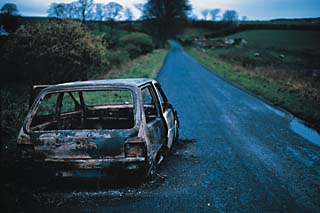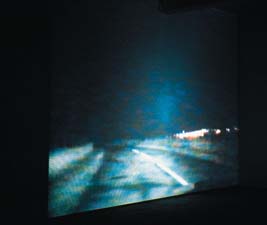| Willie Doherty |
 |
|
The interior of a derelict factory. An overcast day. A scene of total destruction. The roof of the factory has collapsed and the floor is completely covered with twisted metal wreckage and the usual fittings found in a small manufacturing unit. A small country road flanked on either side by fields and hedges. Dusk. This scene of familiar rural tranquillity is broken only by the presence of a burnt-out car at the side of the road. All the windows are smashed and the interior is completely gutted. Small pieces of glass and other debris lie close to the vehicle. These descriptions of two of my photographs suggest the possibility of a narrative. However, the potential for narrative development is resisted. Instead the viewer is compelled to move beyond the immediate surface of the photograph and to examine the specific details of social and economic experience embedded within the image. This act of resistance is central to the work and creates a point of contact with the marks and the residue of actual incidents and events in particular places. These photographs owe nothing to the documentary tradition. They do not propose any evidence of truth. Their open-endedness and contingency implicate the present as much as the past. They exist as objects in another reality from their time of production; the reality of a mediated second hand experience, of fictionalised accounts merging with historical and socioeconomic data. Their job is to be there. They occupy space in an uncertain present, a past which is in the process of being denied and a future without history. Derry, north of Ireland - January, 1995 |
 |